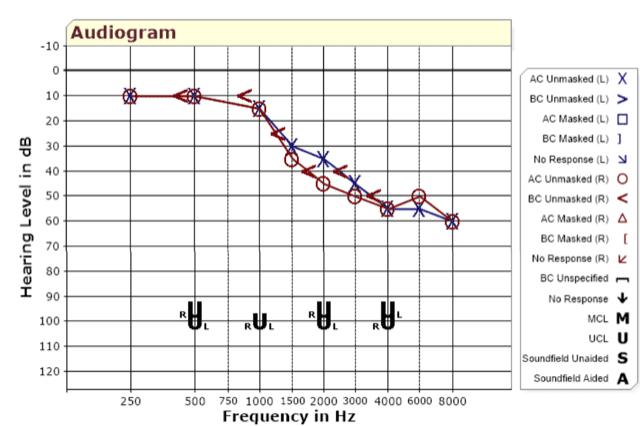Part of understanding your hearing test is being aware of what to expect during a basic hearing evaluation.
Firstly, you will be seated in a soundproof booth, and single-use foam earphones will be inserted into your ear canals.
One of our audiologists will ask you to push a button or raise your hand when you can barely hear a series of beeps (tones) presented at various frequencies (pitches).
We will then record the softest beep that you heard reliably—meaning you heard it at least 2 to 3 times.
To determine whether your hearing loss is the result of a mechanical issue (conductive hearing loss), sensorineural hearing loss, or a combination of the two, we perform a bone conduction test.
For this test, we fit you with a headband that goes behind one of the ears.
This process provides a different form of sound transmission using vibration, which bypasses the eardrum and the middle ear bones in a direct path to the auditory nerve.
When you hear the beeps/tones, you will push a button or raise your hand.
Hearing isn’t normal vs. abnormal, and there isn’t a set percentage of hearing loss.
There is a spectrum from mild to profound hearing loss. The guidelines for what constitutes normal hearing are the same for people 25 to 85 years old, with more strict guidelines for pediatric patients.
Mild hearing loss is from 25 to 39 dB, moderate hearing loss is from 40-59 dB, severe hearing loss is from 60-89 dB, and profound hearing loss is 90+ dB.
Sometimes with profound hearing loss, the patient is unable to hear the sound no matter how loud it gets.

If bone conduction thresholds (using the headband) are in the normal range and are significantly better than air conduction thresholds (through the foam inserts), you have conductive hearing loss, a problem with the mechanical (moving parts) structures of the ears.
If bone and air conduction thresholds are in the hearing loss range and they match, you have a sensorineural hearing loss, which indicates a problem in the cochlea (organ of hearing), auditory nerve, or up the auditory pathway in the brain.
If bone conduction thresholds are in the hearing loss range but are still significantly better than air conduction thresholds, you have a mixed hearing loss, which is a combination of conductive and sensorineural hearing loss.
An audiogram is organized by both pitch (Hz) and loudness (dB).
Low-frequency sounds (such as bass tones and vowels) are on the left side of the graph, and high-frequency sounds (such as treble tones and most consonants) are on the right side of the graph.
Rarely is hearing loss exactly the same across the frequency spectrum; the shape of the graph will look slightly different for everyone.
However, hearing loss does seem to follow a distinctive pattern for both men and women.
The most common shape of hearing loss that we see in men is high-frequency hearing loss; a common observation when someone has a high-frequency loss is “I can hear, but I can’t understand” or “People sound like they’re mumbling even when they’re not.”
For women, the most common configuration of hearing loss is a flat hearing loss; for this shape of hearing loss, both speech loudness and clarity are an issue.
The least common shape is a low frequency ascending hearing loss—this occurs less than 1% of the time.
This loss can be caused by many things, including autoimmune ear disorders and a high risk of poor cardiovascular health.

Now let’s take a look at this audiogram. It’s color-coded red and blue—red O’s for right and blue X’s for left.
Each X or O marks an air conduction threshold, which is how your hearing loss is plotted.
The thresholds shown are very similar between the ears, which means we know that the hearing loss is symmetrical.
The label on the left side of the graph shows the hearing level in decibels (dB HL). This is what the loudness of the sound is measured in.
Looking at the bottom of the graph, you can see the frequencies measured in Hz. The high pitches (frequencies) can be found toward the right side of the graph, while the low pitches can be found toward the left side.
The test results recorded on this graph depict low pitches being in the normal range and high pitches in the moderate hearing loss range.
The red arrows are the bone-conduction thresholds. Since the bone conduction and air conduction results are almost the same on this audiogram, the hearing loss is defined as sensorineural.
All of this put together is interpreted as a symmetrical mild to moderate high-frequency sensorineural hearing loss.
This type and severity of hearing loss would be treated by amplification and auditory rehabilitation—hearing aids!

There are some hearing test results that can indicate we should refer you to an ear, nose, and throat (ENT) physician for further evaluation and possible medical treatment.
For example, a conductive or mixed hearing loss is often a medically treatable condition where you may recover some if not all of your hearing.
We would always recommend referral to an ENT for things like sudden onset hearing loss, unilateral hearing loss within the last 90 days, a significant asymmetry in hearing, or sudden fluctuation in hearing ability.

Going Beyond Understanding Your Hearing Test
While the basic hearing test is very helpful when it comes to ruling out the medical causes of hearing loss, it’s just the tip of the iceberg when it comes to treating communication issues.
That is why we always suggest a Functional Hearing Assessment as part of our Connect 365 Treatment Plan.
If you would like to schedule a Connect 365 Functional Hearing Assessment, please call us at 256-319-4327 or submit a contact request, and one of our helpful team members will call you back shortly.

